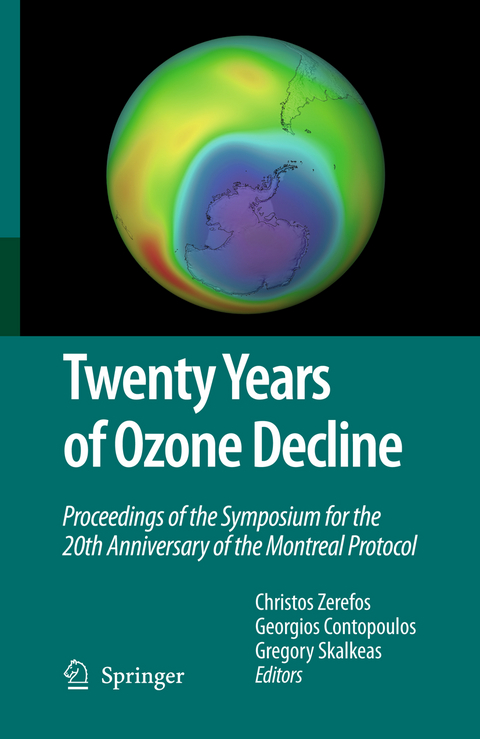
Twenty Years of Ozone Decline
Springer (Verlag)
978-90-481-2468-8 (ISBN)
Opening Ceremony.- Welcome Address.- Statement from the Executive Secretary for the Vienna Convention and the Montreal Protocol.- Opening Address.- Science Inspiring Diplomacy: The Improbable Montreal Protocol.- Keynote Speeches.- Stratospheric Ozone Depletion.- Atmospheric N2O Releases from Biofuel Production Systems: A Major Factor Against “CO2 Emission Savings”: A Global View.- The Long History of Ozone Measurements and the Early Search for Signs of a Trend.- The History of Total Ozone Measurements; the Early Search for Signs of a Trend and an Update.- The Long History of Ozone: Analyses of Recent Measurements.- The Long History of Ozone Measurements: Climatological Information Derived from Long Ozone Records.- Ozone Measurements.- International Multi-Instruments Ground-Based Networks: Recent Developments Within the Network for the Detection of Atmospheric Composition Changes.- International Balloon Measurements for Ozone Research.- The Role of Airborne Science in the Study of Polar Ozone.- Role of Satellite Measurements in the Discovery of Stratospheric Ozone Depletion.- Estimating When the Antarctic Ozone Hole will Recover.- The European Arctic Ozone Campaigns.- Operational Monitoring of the Antarctic Ozone Hole: Transition from GOME and SCIAMACHY to GOME-2.- An Overview of Strategic Ozone Sounding Networks: Insights into Ozone Budgets, UT/LS Processes and Tropical Climate Signatures.- Global Observations—The Key to Model Development and Improved Assessments.- Ozone and Climate-Dynamics.- The Rise and Fall of Dynamical Theories of the Ozone Hole.- Investigations of Climate–Ozone Connections with Coupled Climate–Chemistry Models (CCMs): Another Step Forward.- Stratospheric Ozone Depletion and Tropospheric Chemistry.- Tropospheric Ozone Climate–ChemistryInteraction: Aspects of Climate Changes.- Metrics for Ozone and Climate: Three-Dimensional Modeling Studies of Ozone Depletion Potentials and Indirect Global Warming Potentials.- Stratosphere—Troposphere Interactions in a Chemistry-Climate Model.- Winter Ozone Transport Variations and the Montreal Protocol Impact as Revealed by the Total Ozone Ground-Based Measurements over the Russian Territory in 1973–2005.- Solar Ultraviolet Measurements and Effects.- Solar UV: Measurements and Trends.- Ozone and Ultraviolet Radiation: Informing the Public.- A Contemporary Strategy for Sun Exposure.- Initiatives – Recent Reports.- Findings from the 2006 Ozone Scientific Assessment for the Montreal Protocol.- SPARC Science Supporting the Montreal Protocol.- Industry and the Importance of Science to Business.- How Science Guides Industry Choice of Alternatives to Ozone-Depleting Substances.- The Importance of Chemical Substitutes to Chlorofluorocarbons (CFCs).- Perspectives on the Roles of Science, Scientific Assessments, the Science/Policy Interface and Industry.- The Role of Financial Assistance by the Multilateral Fund in Technology Change to Protect the Ozone Layer.- Conclusion.- Athens Statement.
| Erscheint lt. Verlag | 2.6.2009 |
|---|---|
| Zusatzinfo | XII, 470 p. |
| Verlagsort | Dordrecht |
| Sprache | englisch |
| Maße | 155 x 235 mm |
| Themenwelt | Sachbuch/Ratgeber ► Natur / Technik ► Natur / Ökologie |
| Naturwissenschaften ► Biologie ► Ökologie / Naturschutz | |
| Naturwissenschaften ► Chemie | |
| Naturwissenschaften ► Geowissenschaften | |
| Naturwissenschaften ► Physik / Astronomie ► Angewandte Physik | |
| Technik ► Umwelttechnik / Biotechnologie | |
| ISBN-10 | 90-481-2468-9 / 9048124689 |
| ISBN-13 | 978-90-481-2468-8 / 9789048124688 |
| Zustand | Neuware |
| Haben Sie eine Frage zum Produkt? |
aus dem Bereich


